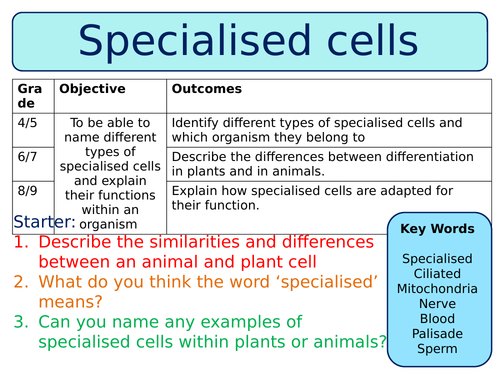

This is a lesson aimed at meeting specification points within the new AQA GCSE (2016) Biology 'Cells' SoW.
For more resources aimed for the new AQA GCSE specification please visit my shop: https://www.tes.com/teaching-resources/shop/SWiftScience
Pupils will start by looking at the differences between unicellular and multicellular oganisms and what it means for a cell to be 'specialised'.
Pupils will then focus on the difference between stem cells in animal and plant cells, they will read a bit of information on this topic and answer questions in their books. Pupils can then peer-assess their work using the answers in the PowerPoint.
In the next task Pupils can either use posters places around the room or they each get given a different card with a different specialised cell and they need to complete a table of information on the structure and function of various specialised cells. These include: palisade cell, white blood cell, nerve cell, red blood cell, ciliated epithelial cell, sperm and egg cell.
The last activity pupils will need to complete a past-paper question to assess their knowledge. Pupils can then self-assess their work using the mark scheme provided.
All resources are included, please review with any feedback :)
For more resources aimed for the new AQA GCSE specification please visit my shop: https://www.tes.com/teaching-resources/shop/SWiftScience
Pupils will start by looking at the differences between unicellular and multicellular oganisms and what it means for a cell to be 'specialised'.
Pupils will then focus on the difference between stem cells in animal and plant cells, they will read a bit of information on this topic and answer questions in their books. Pupils can then peer-assess their work using the answers in the PowerPoint.
In the next task Pupils can either use posters places around the room or they each get given a different card with a different specialised cell and they need to complete a table of information on the structure and function of various specialised cells. These include: palisade cell, white blood cell, nerve cell, red blood cell, ciliated epithelial cell, sperm and egg cell.
The last activity pupils will need to complete a past-paper question to assess their knowledge. Pupils can then self-assess their work using the mark scheme provided.
All resources are included, please review with any feedback :)
Get this resource as part of a bundle and save up to 53%
A bundle is a package of resources grouped together to teach a particular topic, or a series of lessons, in one place.
Something went wrong, please try again later.
Excellent well structured lessons.
Report this resourceto let us know if it violates our terms and conditions.
Our customer service team will review your report and will be in touch.
£3.00
